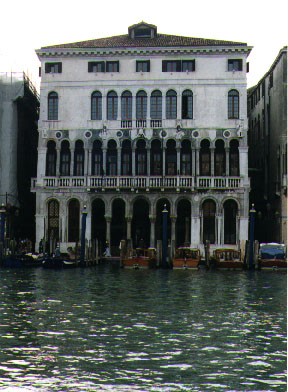CA' CORNARO
PISCOPIA, a Veneto-Byzantine palace of the "fondaco" style, was erected
c. 1200 by an unidentified patron. The palace passed to Andrea
Zane, previously of S. Stin parish, in 1316 and was acquired by Cav.
Federico Cornaro (SA-35) and his brothers, previously of S. Aponal
parish, in 1364. Soon the palace was the site of several important
state visits, first by Albert Hapsburg, future Duke of Austria, in
September 1361, and then by Peter I Lusignan, King of Cyprus, in December
1366.
The latter visit
was one of the pivotal events in the Cornaro family's rise to wealth
and power, which was based heavily on its role in the commercial and
political life of the Kingdom of Cyprus. The lion rampant of the Lusignan
family is among the decorations on the frieze of the palace.
The two lower
floors comprise the original Gothic structure, with the two upper
floors added in the 1500s.

